Port O’Connor History
This history of the Port O’Connor is rich and very significant to Texas and the development of the New World.
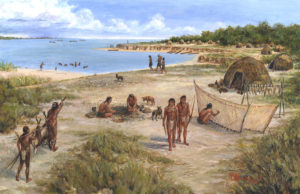
Karankawa Indians
Before the area was fully colonized by Europeans, it was the domain of the Karankawa Indians. These were extremely tall and strong people, who were expert hunters, fishermen, and often feared for their well-known fighting skills.
Port O’Connor is within sight of the old Pass Cavallo, the passage into Matagorda Bay from the gulf a few miles offshore. This was once a deep water passage for ships of sail from the 15th through 19th centuries. It is also where the famous French explorer, Robert de La Salle, shipwrecked his expedition fleet in 1684, and from there continued his expedition on land.
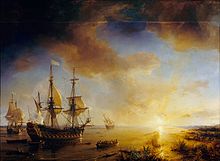
Labelle – LaSalle’s ship.
Port O’Connor, named for a prominent Victoria family, was laid out in 1909 by the Calhoun Cattle Company on the 70,000-acre Alligator Head Ranch formerly owned by Thomas O’Connor. Purchase price for most of present acreage was $600. Property was originally part of a Spanish Land Grant. Buyer was Port O’Connor Townnsite Company.
By 1911, the International-Great Northern Railroad had reached the community, which was named for O’Connor.
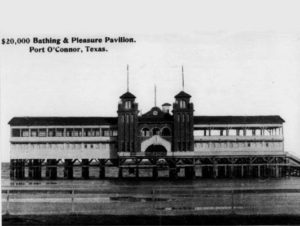
Pleasure Pavilion in Port O’Connor 1914
By 1914, the town had become the summer resort terminus of the St. Louis, Brownsville, and Mexico Railway. A hotel and Pleasure Pavilion were built, and most of the fine summer homes were built and owned by families from Victoria. The population reached 350.
That year the community also had three general stores, two churches, two fish and oyster plants, a bank, an ice plant, and a lumber company. Farmers in the area raised figs, and citrus fruit and shipped their produce to Port O’Connor’s Fig Orchards Company for processing. This phase of Port O’Connor ended violently with the hurricane of September 1919 – storms had no names in those days.
Port O’Connor remained a small fishing village for the next four decades. The primary business activities consisted of a small number of bay shrimp and oyster boats. With Pass Cavallo being the only access to the Gulf, due to it’s shifting channels, Gulf access was limited. These decades had many storms, but only the 1945 storm caused major damage. In 1939 the Gulf Intracoastal Waterway reached Port O’Connor linking New Orleans with Corpus Christi. Hurricanes in 1942 and 1945 damaged the town but it recovered.
The revival of the town as a summer fishing resort reached it’s peak with the completion of the Matagorda Ship Channel and Jetties. Many Houston area fisherman built summer weekend or retirement homes, and Port O’Connor again became a popular resort. The deep water channel to the Gulf attracted a sizeable shrimp fleet, adding to the prosperity of the times.
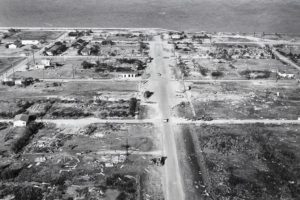
Hurricane Carla Devastation 1961
Again, the growth and prosperity, ended violently in September 1961 as Hurricane Carla with winds over 140 mph made its landfall. Between 17 ft tides and the vicious winds, the town was completely destroyed. However, once again Port O’Connor had the courage to rebuild. Port O’Connor’s close proximity to Matagorda AFB helped with the recovery.
Offshore oil drilling in the 1960’s through the early 1980’s created another business boom in Port O’Connor. The town’s population reached 1,010 in 1969. The number of businesses reached a high of 27 in 1981. The offshore oil platforms also brought with them enhanced deep sea fishing.
Sports fishing is currently the major economic engine of Port O’Connor. Fishing guides operate in both bay and gulf waters. There are so many types of fishing areas available in and around Port O’Connor that it is rare when the weather can completely stop all fishing. Fishing ranges from the deep water fishing of the Gulf to the shallow bays.
Railroads
Spurred turn of the century growth. The Calhoun County Cattle Company, the O’Connor Alligator Ranch is credited with bringing the I & GN “Frisco” railroad line to Seadrift and Port O’Connor. With the growth of the railroad spur lines came the land development companies. Regular trains operated between Bloomington and Port O’Connor. Excursion trains brought people to stay at the LaSalle Hotel, a beautiful brick structure which cost $40,000 to build. A turntable existed in Port O’Connor to turn the train around for the trip back to Bloomington.
Schools
Port O’Connor School – In 1910 a new 2 story school house was built. This school like Port O’Connor has weathered many hurricanes. In 1950, Port O’Connor School was reduced to 8 grades and currently it is an elementary school with grades Kindergarten to Grade 6. Port O’Connor is very proud of the fact that their school has been designated an Exemplary School on more than one occasion.
Early Settlements
Before Port O’Connor existed, there was a settlement consisting of warehouses and wharfs on Saluria Bayou. This was also the location of the Coast Guard Station and Boathouse in which large rowboats were kept which were used to row out and rescue ships that were in distress.
Matagorda Island Lighthouse
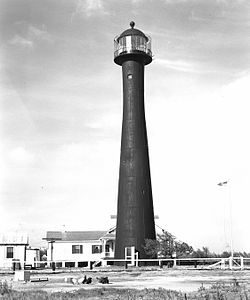
Matagorda Island Light House
Port O’Connor, Pass Cavallo, Matagorda Lighthouse, was the site of Civil War skirmishes between Confederates and the Federals fighting over control over the shipping lanes and lighthouse. Saluria was founded in about 1845 on the northeastern tip of Matagorda Island on Matagorda Bay near Pass Cavallo. The location of Saluria made it a natural port because all vessels coming in from the Gulf came through Pass Cavallo to Port Lavaca, Indianola, and other ports on the bay. The US government built a lighthouse there in 1858. The Confederate forces attempted to destroy the lighthouse when they attempted to evacuate Matagorda Island during the Civil War. The Confederate force buried the lighthouse lens in the sand nearby, and it was recovered after the war ended. The lighthouse lens is presently on display in the Calhoun County Museum in Port Lavaca. A stagecoach made trips three times a week from Saluria to the southern portion of Matagorda Island where a ferry would take them to the mainland.
Matagorda A.F.B.
During WWII there were numerous airfields located along the barrier islands in close proximity to Port O’Connor. Ferry service was operated out of Port O’Connor to ferry Air Force members serving Matagorda AFB to and from the island.
Darlington
Concrete ships can float! The skeleton of the Darlington remains in the Gulf surf just off Matagorda Island about 15 miles southwest of the lighthouse and is a famous fishing spot, weather permitting for Port O’Connor fisherman. The Darlington was built in Texas as part of the shipbuilding effort in WW1. It is believed that the Darlington was made to be towed and broke loose in heavy seas during its maiden voyage. The concrete ships were a result of a wartime shortage of steel.
World War II
During WWII about 7 or 8 miles off the Port O’Connor jetties on an early morning of July 6, 1942, the German submarine U-171 sent the 4,350 ton ship Oaxaca to the bottom of the Gulf. The ship was a former German freighter that had been confiscated in Mexico. Amongst its cargo was a shipment of rubber bales, several of which washed up on Matagorda Island.
LaBelle
The Texas Historical Commission Archaeologists pulled a cannon out of Matagorda Bay which was thought to be from the French Explorer LaSalle’s flagship, the LaBelle. Later the actual remains of the LaBelle were found in the bay near the entrance to the Port O’Connor jetties and have been recovered it artifacts placed in various State and County museums.
Port O’Connor Library
In 1986 Port O’Connor Library was established in a small space in the Fire Dept. Building. In 1988 the Library received a Certificate of Incorporation of Port O’Connor Library which was signed by : Beth Coats, Nancy Childers, June Green, Jeffra Ragan, and Ruth Crandall. In 1989 the existing library building was added on to the Fire Dept. Building and the Library became a branch of the Calhoun County Library System. Shirley Gordon was hired as librarian.
First Baptist Church
The Baptist Church was officially organized on January 23,1938 through the efforts of two familes: Mr. & Mrs. P.L. Lewis and Mrs. H..P. Clark. However , its true beginnings were on April 11, 1911 when the POC Townsite Company sold a plot of ground at the corner of Jefferson and Fifth Street to trustees of the First Baptist Church of POC. In 1947 Chapel No.3 at Camp Hulen, Texas was purchased from the War Dept. and in 1948 was barged to POC. The Church survived Hurricane Carla but needed extensive repairs. The present pastor is Marcos Gohlke.
Volunteer Fire Department
The POC Volunteer Fire Department was organized in 1952. Ray Rather was the first fire chief. The fire truck was kept in a garage by Madden’s Lounge, and a siren alerted the volunteers and the community.
